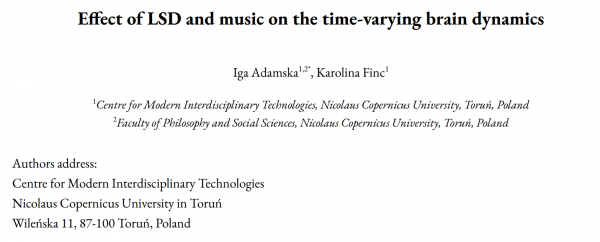Publikacja pracy Igi Adamskiej
Z wielką przyjemnością dzielimy się informacją o opublikowaniu preprintu pracy jednej z założycielek naszego Koła, a aktualnie członkini pod opieką dr Karoliny Finc.
Effect of LSD and music on the time-varying brain dynamics - dostępne pod adresem: https://www.biorxiv.org/.../2022.04.04.486673v1.abstract. W tym projekcie został wykorzystany zbiór danych z OpenNeuro w celu zbadania efektu muzyki na dynamikę stanów mózgu po spożyciu LSD (lysergic acid diethylamide).
Iga rozpoczęła pracę nad projektem na pierwszym roku studiów licencjackich, nauczyła się analizy danych fMRI w Pythonie oraz stworzyła kod open-source do analizy stanów mózgu w Pythonie dostępny na platformie GitHub. Otrzymała również grant Grants4NCUStudents na stworzenie zestawu narzędzi do analizy i wizualizacji dynamiki stanów mózgu, który zakończyła sukcesem. W tym roku obroni pracę licencjacką na podstawie tej pracy.
Abstrakt
Psychedelics are getting closer to being widely used in clinical treatment. Music is known as a key element of psychedelic-assisted therapy due to its psychological effects, specifically on the emotion, meaning-making and sensory processing. However, there is still a lack of understanding in how psychedelics influence brain activity in experimental settings involving music listening. The main goal of our research is to investigate the effect of music, as a part of “setting”, on the brain states dynamics after lysergic acid diethylamide (LSD) intake. We used an open dataset, where a group of 15 participants underwent two scanning sessions under LSD influence and under placebo. Every scanning session contained three runs: two resting-state runs separated by one run with music listening. We applied K-Means clustering to identify the repetitive patterns of brain activity, so-called brain states. For further analysis, we calculated states’ dwell time, fractional occupancy and transition probability. We found that the brain states’ dynamics during the resting-state and listening to music on both LSD and placebo does not differ significantly. Furthermore, we found that the music itself could potentially have a long-term influence on the resting-state, in particular on the states involving task-positive networks. Collectively, these findings suggest that the whole-brain states’ dynamics during psychedelic experience and placebo is relatively stable, however, music, as a crucial element of “setting”, can potentially have an influence on the subject’s resting-state. Further studies should replicate these results on a larger sample size.

